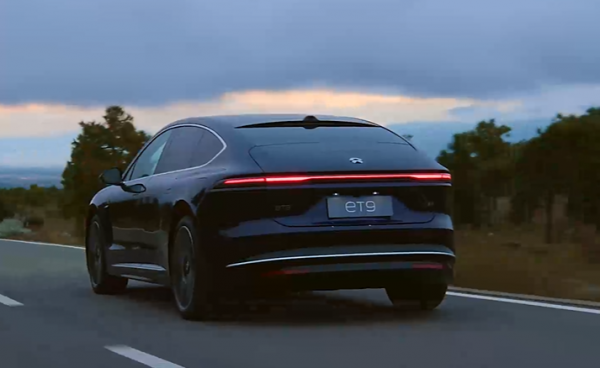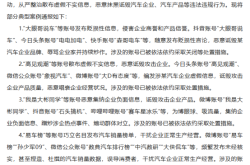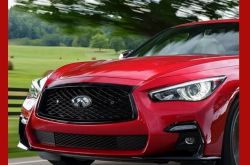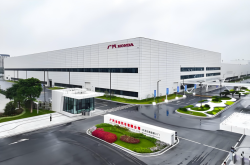Multi-brand "Counterattack" Attempts: NIO Cannot Afford to Fail in 2025
![]() 01/03 2025
01/03 2025
![]() 678
678

Perhaps Li Bin did not foresee that NIO's NIO Day event at the end of 2024 would spark such controversy.
At the recent grand NIO Day event, NIO unveiled two vastly different new models: the premium executive flagship sedan ET9, priced at 788,000 yuan, and the budget-friendly Firefly, priced at 148,800 yuan, marking NIO's third brand.
With these additions, NIO now boasts 11 models across three brands, covering a price range from 150,000 to 800,000 yuan, making it one of the new energy vehicle (NEV) makers with the most diverse portfolio.
Amidst fierce competition and widespread austerity in the automotive industry this year, NIO's strategy of not pursuing blockbusters, insisting on not developing extended-range or hybrid models, and adhering to a multi-brand approach, goes against the grain.
This approach is rooted in founder Li Bin's commitment to NIO's premium electric vehicle positioning. However, the challenges of pursuing a multi-brand and premium strategy far outweigh those of other paths. How long can unprofitable NIO sustain this approach? Is 2025 a pivotal year for NIO?
Two New Models, Targeting Two Distinct Segments
The ET9, which was unveiled as early as December 2023, is no stranger to the public. As Li Bin puts it, it is crucial to demonstrate where NIO's over 50 billion yuan in R&D expenditures have gone, and a tangible car is the most intuitive way to do so.
Thus, the ET9 has been entrusted with being "the crystallization of NIO's decade-long technological innovation," integrating NIO's cutting-edge technology. Features include the Sky Ride chassis, a full-vehicle 900V high-voltage architecture, two self-developed NIO Jade NX9031 intelligent driving chips, and a Qualcomm Snapdragon 8295 chip, collectively forming a central computing platform.
With this technological support, the ET9 is the first to adopt the new flagship intelligent system - Cedar. The large model capability is deeply integrated into the system's underlying layer, enhancing full-modal perception, end-to-end cognition, and emotional engagement.
As an executive flagship sedan, the cabin experience is paramount, and NIO has put considerable effort into this aspect. The rear executive seats feature a self-developed seat frame, offering a first-class cabin experience. For privacy and quietness, the ET9 employs full-car privacy glass and advanced active noise reduction (ARNC).
In short, NIO has loaded the ET9 with advanced features, making it a pinnacle of NIO's premium technology.
On the other hand, the Firefly follows a completely different approach: targeting the compact car segment, it emphasizes compactness and agility. Its headlights, composed of three circular rings, are quite distinctive, quickly capturing public interest and discussion, sometimes even surpassing that of the ET9.
The launch of these two new models signifies that NIO has ventured into two distinct segments simultaneously: the ET9 aiming upwards to tell a premium story, and the Firefly delving downwards into the compact car segment. However, neither model is expected to be a high-volume seller; Li Bin admits that monthly sales of 1,000 ET9s and a few thousand Fireflies would already be considered successful.
Yet, neither of these segments has been successfully navigated by a Chinese-owned brand to date. The most successful premium compact cars are MINI and smart, largely benefiting from the luxury and premium positioning of BMW and Mercedes-Benz, respectively.
For NIO, its premium brand positioning has yet to truly materialize, and in the Chinese market, premium compact cars are unlikely to be the first or even second choice for most Chinese families. For the Firefly, the larger market lies overseas, but this terrain is equally challenging.
An executive flagship sedan is a double test of product strength and brand power, precisely where the biggest barriers lie for BBA (BMW, Benz, Audi). The legacy of a century-old automotive brand is not built overnight.
By diving into two of the most challenging segments right off the bat, NIO has chosen to fight on two fronts, both of which are formidable.
Ten Years, "Three Children," NIO's Multi-brand Strategy Takes Shape
The recently concluded year 2024 was significant for NIO in terms of brands and products. The main NIO brand officially launched the ET9, aiming to penetrate the premium market with an executive flagship sedan; the second brand Roadster's first model, the L60, was officially delivered, entering the mass market in search of stable sales growth; and the third brand Firefly made its debut, entering the premium compact car segment, marking an important step in NIO's global layout.
With this, NIO now has a matrix of 11 models across three brands, covering a price range from 150,000 to 800,000 yuan, making it one of the most diverse NEV makers among the new forces. NIO has a classic description for the positioning of these three brands: NIO for business, Roadster for family, and Firefly for self-indulgence.
The strategy is clear, with distinct positioning for each brand. NIO focuses on the premium segment, while Roadster takes on the volume sales KPI. Firefly's positioning is more suitable for overseas markets. Notably, NIO still adheres to a pure electric strategy across all its brands.
However, in the broader automotive industry context, NIO appears somewhat "alternative." For a long time, Geely, which followed the strategy of "having more children to fight better," has shifted to contracting its sub-brands. NEV brands like Lixiang and Xiaomi have chosen a blockbuster strategy, focusing on one or a few models to penetrate the market. Even Xpeng, which has adhered to a pure electric strategy for a decade, has announced its entry into the extended-range market.
In contrast, one wonders why NIO persists with a multi-brand and pure electric route. What gives NIO the confidence?
This may require a longer timeline. Since NIO's inception, Li Bin has repeatedly stated publicly that the multi-brand strategy was planned from the outset and was not a whim, with a premium positioning at its core.
Looking at the automotive industry, the few automakers that have maintained a long-term premium route have almost invariably chosen to establish separate brands. Examples include Mercedes-Benz's Maybach, Volkswagen's Porsche, BMW's Rolls-Royce, Toyota's Lexus, and Nissan's Infiniti. If NIO wants to maintain its premium tone, the responsibility of volume sales and "supporting the family" must fall on more mass-market-oriented brands.
The third brand, with its overseas expansion responsibility, targets the European market for small cars priced between 20,000 and 30,000 euros. According to public data, the global small car market has a total size of over 10 million units, which is quite attractive to NIO. The premium compact car segment is a rare blank space in the fiercely competitive automotive brand landscape, and NIO aims to differentiate itself and open up more possibilities for overseas expansion.
On the other hand, NIO's commitment to pure electric across all its brands is closely related to its proprietary battery swapping model. To date, NIO has deployed 2,785 battery swapping stations nationwide, including 909 located on highways. Moreover, NIO has joined forces with several automakers to form a battery swapping alliance. Battery swapping is the most distinctive feature and service of NIO vehicles.
After a decade, NIO's multi-brand strategy has taken shape, with the three brands forming a synergistic force. In Li Bin's words, "the country encourages having three children." But when will NIO become profitable?
When Will NIO Become Profitable?
Despite NIO's many accomplishments in 2024, Li Bin was not satisfied with the company's performance, giving it only a score of 60 out of 100.
In Li Bin's view, 2021 was a watershed moment for NIO's development. Over the past three years, NIO's growth has fallen short of its targets, lagging behind its early plans by about two years.
Sales figures provide the most intuitive measure. In 2024, NIO's annual sales just exceeded 200,000 units. Among peer brands, NIO's sales growth has lagged in the past two to three years. In 2022, NIO sold 122,500 units, compared to 133,000 for Lixiang and 1.8685 million for BYD; in 2023, NIO sold 160,000 units, compared to 376,000 for Lixiang and 3.0244 million for BYD.
The above data shows that while NIO's sales have increased annually, the pace has been far slower than that of BYD and Lixiang, especially BYD, which has far surpassed other NEV makers.
Apart from lagging sales, losses have also been a lingering concern for NIO. According to the third-quarter financial report for 2024, NIO's revenue reached 18.67 billion yuan during the reporting period, but its net loss was still as high as 5.06 billion yuan, a year-on-year increase of 11%.
The goal of profitability still seems a long way off. Li Bin has sensed the danger, acknowledging that the automotive industry will accelerate in 2025, widening the gap between the first-tier, second-tier, and lower-tier players. In an internal letter marking the company's 10th anniversary, Li Bin admitted that the next two years would be critical and that NIO could not afford to fail.
For this reason, even Li Bin, once considered the most daring spender in the automotive industry, has set profitability targets: doubling sales by 2025 and achieving profitability by 2026.
It is understood that Li Bin has set a positive gross margin target for each new model and sub-brand. The L60, launched by Roadster in September 2024, currently has a vehicle profit margin in the single digits. Management expects the profit margin to reach around 10% next year with increased production and delivery volumes. The Firefly is also required to contribute positively to the group's gross margin and generate profits for the company.
Additionally, the premium model ET9, delivered in the first quarter of 2025, has been tasked with achieving higher product margins.
In terms of sales, based on Li Bin's projections, the NIO and Roadster brands are expected to jointly achieve a sales target of 220,000 units in 2024. In 2025, Roadster plans to achieve an average monthly sales volume of 20,000 units, with an annual sales volume of over 200,000 units. Combined with the growth momentum of the NIO brand and the monthly sales of a few thousand units by the Firefly brand, the three brands together can achieve an annual sales volume of over 400,000 units.
Sales and performance are explicit indicators. In recent years, NIO has also fallen behind in autonomous driving, one of the areas where it once led. As one of the earliest NEV makers, NIO was also one of the first to lay the groundwork for intelligent driving. However, as other companies have rapidly iterated their intelligent driving systems in the past two years, NIO has apparently fallen behind and needs to catch up quickly.
NIO's premium positioning is currently perceived by the public mainly through its battery swapping model, refusal to engage in price wars, and superior service. However, when it comes to intelligent driving, NIO lacks a significant market presence and a recognizable signature feature.
NIO appears to be playing catch-up. Shortly after NIO Day, reports emerged that NIO's intelligent driving R&D department had announced a series of organizational structural adjustments. A new technology committee will be established to oversee comprehensive capability building, with platform departments including a large model department, a deployment architecture and solutions department, and a systems department, all fully supporting the delivery team. Additionally, Ren Shaoqing, NIO's vice president of intelligent driving R&D, will personally lead the large model department.
Sales figures, profitability targets, and adjustments to the intelligent driving organizational structure all indicate that NIO has recognized the risks it faces in its operations. Only by proactively seeking change can NIO's future development be salvaged.
Conclusion
The past year, 2024, has seen significant changes in the NEV landscape. On the one hand, several NEV makers, such as Nezha, HiPhi, and Geely, have fallen behind, providing bloody lessons for the industry. On the other hand, companies like BYD, Lixiang, and Hongmeng Zhixing have made significant progress, while Xiaomi's foray into the automotive industry has garnered much attention. Xpeng and Leap Motor have also entered a fast growth track.
Amidst the industry's rapid pace, gaps are gradually widening between brands. In the long run, some are disappointed, while others are satisfied. NIO finds itself at a critical juncture in the racetrack hierarchy: with a little extra effort, it can enter a different realm, but any slight misstep could lead to a repeat of past failures.
2025 will be crucial for NIO, as Li Bin said, "We cannot afford to fail!"






